When searching through pages upon pages about microphones, it can be incredibly daunting as a beginner to understand how to choose the best one.
If you ask five different vocalists what the best microphone for recording vocals is, you might just get five different answers. That’s not exactly helpful, is it?
In this comprehensive beginner’s guide to the best microphone for recording vocals, I will help you narrow down your decision by providing a more in-depth look at the popular types of recording microphones.
By the time you’ve finished reading, you’ll have a deeper understanding of recording microphones and how to choose the right one.
But, if you want the straight answer right now, in most cases, a large-diaphragm condenser microphone is the best type of microphone for recording vocals. Keep reading to find out why.
Why Does It Matter?
The difference between a high-quality microphone and a poor quality one is like the difference between upscale sushi and gas station sushi.
Sure, they’re both fish, but one provides a superior experience in every way, and the other might just make you sick.
When it comes to recording vocals, using the right microphone is critical for getting the best results.
What to Look For in a Microphone
When searching for the best microphone for recording vocals, these are the most important things to look for:
Microphone Type
Dynamic, condenser, and ribbon microphones use different methods to convert sound into electrical energy.
The first step in deciding which microphone to buy is narrowing down the type that can help you produce the best possible sound for your specific needs.
Each mic type has different tonal characteristics. Depending on the kind of sound you want to achieve in the recording, you have to choose accordingly.
In the next section, we go into more detail about the different microphone types used for recording vocals.
Polar Pattern
This is how a microphone picks up sound from its environment. Some microphones can pick up sound from all directions, while others are limited to one specific direction.
Depending on your needs, either one of these could be used to your advantage. Cardioid patterns are the most commonly used polar patterns in recording mics and pick up sound primarily from the front where the microphone is pointing.
To learn more about the different polar patterns, click the link.
Sound Pressure Level
Typically expressed in decibels, the sound pressure level lets you know the maximum volume a recording microphone can handle before the sound will become distorted.
Most Popular Types of Microphones For Recording Vocals
When it comes to recording vocals, the three most popular microphones choices are dynamic, condenser, and ribbon microphones.
There are ups and downs to each one, as well as different types of sounds that they each work best with.
Dynamic Microphones
If you’ve ever seen a live show of any kind that required the lead to hold a microphone, chances are it was a dynamic microphone.
From karaoke nights to interviews on the street to stage performances, dynamic microphones are easily the most commonly used microphones in live settings.
Dynamic microphones work by connecting an inductive coil to a diaphragm and inserting it within the field of a magnet.
When the diaphragm moves, the coil moves, which causes the voltage produced by the coil to vary, which shapes the microphone’s output.
These types of microphones are more rugged and known to be able to take a beating, which is one of the reasons why they’re commonly used in live sound settings.
Most of them also have internal shock mounting that allows for portable use and polar patterns that reject off-axis sounds.
In general, dynamic microphones tend to be more affordable than other types of mics.
Dynamic Mics Don’t Deliver Detailed Sound
Dynamic microphones don’t pick up sound in as much detail as condenser mics do.
The reason is because it takes more sound energy to move the membrane.
Sounds with subtle nuances and higher frequency tones have less mass than mid and low-frequency sounds.
Because of this, if the soundwaves moving through the air don’t have enough mass to make the membrane vibrate, the resulting sound will lack detail.
This is why dynamic mics deliver excellent responses at the low and mid frequencies but are mediocre to reproduce the higher end of the frequency range.
Although the human voice doesn’t contain too many high-frequency components, by having a microphone that picks up sound in greater detail, especially in the higher frequency range, the recorded voice will sound fuller and with higher definition
RELATED POST: Best Dynamic Microphones for Live Vocals
Condenser Microphones
Ah, the condenser mic. My personal favorite. These work a bit differently from dynamic mics in that they use capacitor plates instead of magnets and a coil.
The capacitor plates are supplied with an electric charge from a battery or phantom power.
As the pressure created by sound waves causes the diaphragm to vibrate, it alters the distance between the diaphragm and the backplate, which creates variations in the voltage that generate the mic’s electronic signal.
Because less sound energy is needed for the thin plate to vibrate, condenser mics capture clear, crisp highs and detailed lows, making it very versatile in the full range of frequencies.
How does this change the sound? It causes condenser microphones to be more sensitive to small vibrations than dynamic microphones.
In simpler terms: they pick up everything. This makes them exceptional for recording vocals and instruments.
Condenser microphones are widely used in studio settings for music and podcast recording because of their powerful ability to pick up the subtleties in vocals.
These types of microphones vary in price from moderate to insanely expensive. They can also be somewhat bulky, depending on which one you go with.
Ribbon Microphones
These are known to produce the most natural vintage sound, which is great if you’ve been struggling to find a mic that captures your sound exactly the way you hear it.
Ribbon microphones technically fall under the umbrella of dynamic microphones. However, instead of a diaphragm, they feature a thin ribbon (typically made from aluminum) suspended in a powerful magnetic field.
When sound waves hit the ribbon material, it vibrates. These vibrations create variations in voltage. This voltage is the soundwaves converted into an electrical signal.
Ribbon microphones are typically used to record voices and instruments in the studio.
They have the power to make recorded material sound warmer. It gives instruments like kick drums a booming effect and boosts weak vocals to make them sound richer.
That being said, ribbon mics aren’t all rainbows and butterflies. The downside of ribbon microphones is that they tend to be incredibly pricey, fragile, and require a tremendous amount of care when being worked with.
RELATED POST: Best Ribbon Mics for Recording Vocals
Best Microphone for Recording Vocals
For recording vocals in a studio setting, large-diaphragm condenser microphones are hands down the best option out there.
These are condenser microphones with a diaphragm of 1 inch or more in diameter.
Known for their incredible signal-to-noise ratio, they have the ability to shape sound beautifully.
Artists widely use large-diaphragm condenser microphones to achieve their ideal sound. Some examples are Billie Eilish, Mariah Carey, Eminem, and many more.
For a more detailed explanation of what is a large-diaphragm condenser mic click the link.
Best Large-Diaphragm Condenser Microphones for Recording Vocals
Budget Options
The Samson CO1
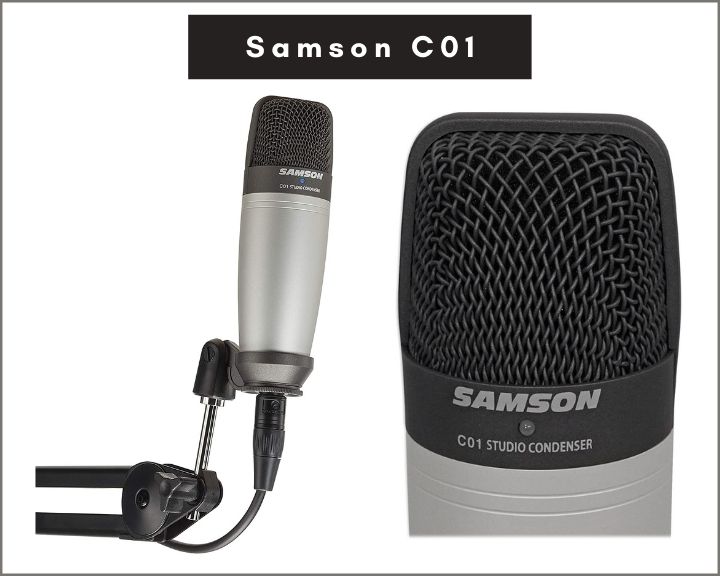
The C01 from Samson is a versatile microphone for a good reason; it delivers a lot of value for a low price.
It is an excellent option for a high-quality recording mic if you’re on a tight budget.
With a wide dynamic range and the ability to handle high SPLs, you can’t go wrong with the CO1.
It is perfect for vocals, pianos, and stringed instruments. It offers a balanced low-end and mid-frequency response with excellent high-end clarity.
It also has a low-frequency roll-off to get rid of unwanted low-end rumble.
It provides you with a lot of value at this price point. It works beautifully and has an excellent build quality.
Audio-Technica 2020
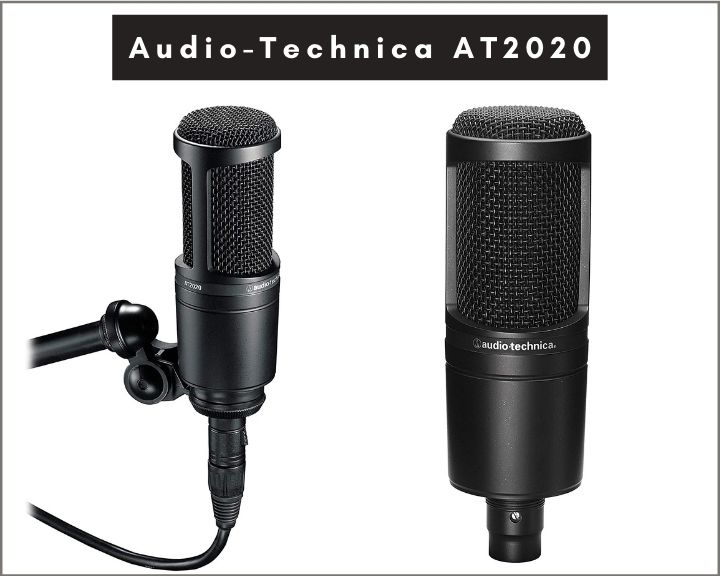
The AT2020 is a medium-sized diaphragm condenser microphone that offers ultra-clear sound. Thanks to its extended frequency response and superior transient response, it delivers smooth, natural sonic characteristics.
It is designed specifically for close-up vocal use in recording studio applications.
Even though this is a budget microphone, vocalists have claimed that when recording using the AT2020, there is nuance and clarity in their voice that helps them articulate and express better than when using other mics.
Maono PM500
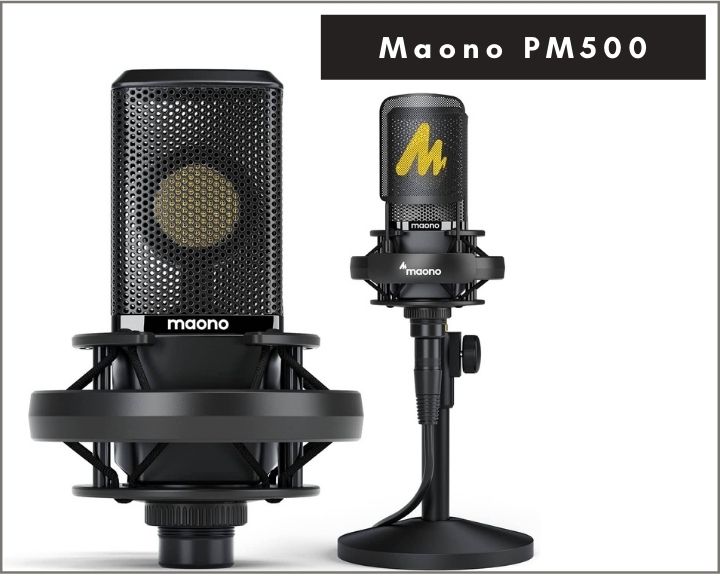
If you are looking for a budget multi-purpose mic for recording vocals, voiceovers, instruments, or podcasting, the Maono PM500 large diaphragm condenser microphone is a good choice.
What I liked the most about this condenser mic was the size of its capsule and the sound quality that it is capable of delivering at this price range. It is important to point out that it is not as sensitive as well-known brands in the industry.
If you need to pick up the most subtle nuances of your performance, you’ll need a mid-level or professional-level mic. But for a beginner or intermediate vocalist, recordist, or podcaster, this is an excellent option.
Most condenser microphones in this price range come with a capsule that is 16mm or less in diameter. When you see mics in the large capsule category, they are usually between ¾ of an inch and 1 inch (2.54mm) in diameter.
The PM500 comes with a large 34mm (1.34″) pickup capsule offering a cardioid polar pattern, a frequency response between 20Hz and 20kHz, and 120dB maximum SPL.
With a large diaphragm condenser capsule, you get more sound detail because the surface area of the capsule can pick up more of the acoustic energy in the form of vibrations produced by the sound source, which is what you need when recording most sound sources.
Although you can get a higher sound sensitivity with other more expensive microphones if you are on a smaller budget, this might be the right mic for you.
There are many condenser mics on the market but not so many at this price range that offers good sound quality, plus it comes bundled with everything you need to get started right away.
You will get the mic, a table mic stand, a custom shock mount, a pop filter, and an XLR audio cable in the box.
Mid-Level Options
Rode NT1A
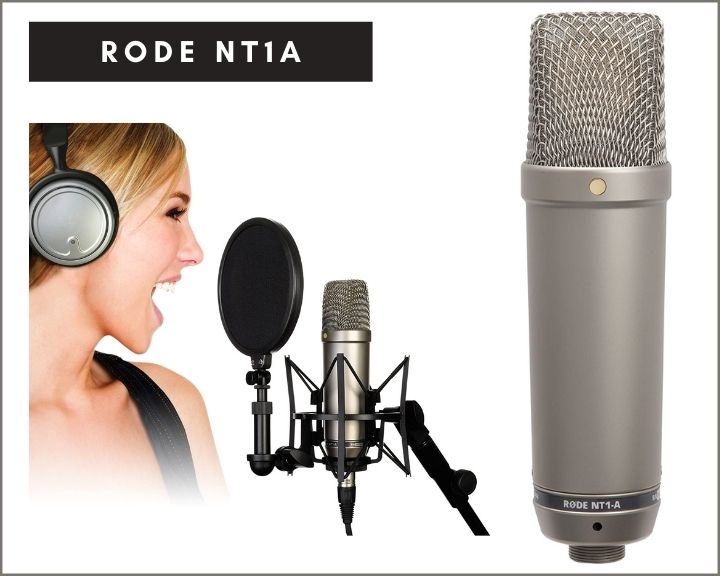
This popular mid-level cardioid microphone boasts impressive features like a wide dynamic range, high SPL capacity, and an ultra-low self-noise level of just 5dBA.
There are many condenser mics out there that are of good quality, but the Rode NT1A was designed especially for recording vocals.
Plus, Rode designs and manufactures all of its microphones and components with the highest quality control practices in their factory in Australia.
The beauty of this microphone is that it reproduces what you put in front of it, delivering the warmth and extended dynamic range that produces clear crisp vocal recordings. This is as good as it gets at this price range.
AKG C214
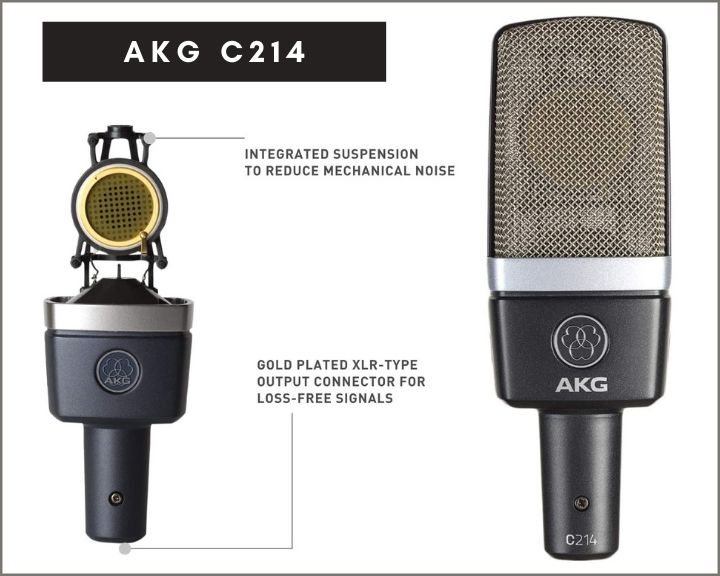
The C214 was designed from the ground up to deliver premium sound. It is a super-sensitive microphone that produces incredibly detailed sound for recording vocals.
For the best results, use this mic in a controlled environment like a studio to eliminate unwanted noise from the surrounding environment.
Other than that, the sound it captures is phenomenal. You won’t hear the typical underlying hiss that you get with most raw recordings, especially if you use a good quality preamp or audio interface for recording vocals.
It features a suspension system specially designed to reduce mechanical noise and resonance to deliver excellent tonal accuracy.
This microphone sounds excellent on female vocalists. It delivers a mellow tone that goes perfectly well with the female vocal range.
Professional Grade Options
Neumann TLM 103
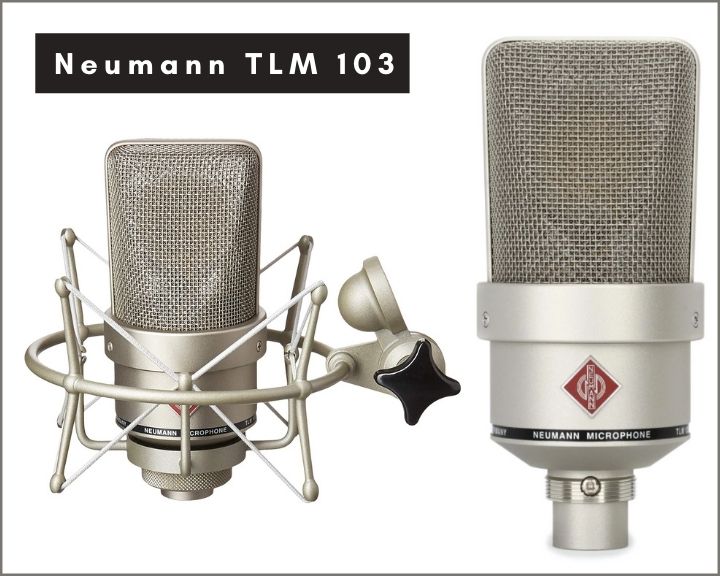
The TLM 103 delivers the classic Neumann sound used in so many professional recordings all over the world.
Initially, microphones used a transformer to match impedances. The Neuman TLM 103 is a transformerless design that uses electronic circuitry to achieve the same results.
This microphone delivers transparent sound, perfect for male vocalists. It picks up the sound without adding any coloration to the tone.
Thanks to its extremely low self-noise level, the TLM 103 can reproduce the smallest signals virtually noise-free.
No wonder artists like Drake use this mic for recording their songs in the studio.
Sony C-800G
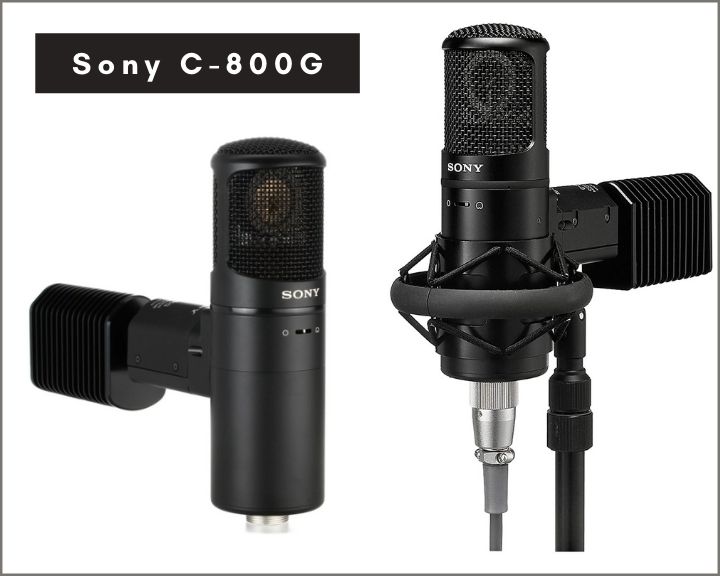
This multi-pattern condenser mic is the crème de la crème of condenser microphones.
It is the go-to recording mic for artists such as Mariah Carey, J. Cole, Dr. Dre, Kanye West, and Eminem.
One of its best features is that it uses a tube to convert the impedance between the input and output actively.
When sound passes through a tube, it creates a unique tone that can’t be compared with solid-state devices. The reason is because vacuum tubes add harmonics to the signal, which enriches the sound in a unique way.
It also features two electronically selectable polar patterns, cardioid and omnidirectional.
The incredibly low self-noise and high sensitivity make it a superstar mic that produces first-class sound for everything from vocals to electric guitar. This is one of the best-sounding microphones ever made, delivering a mellow, warm tone that only tube mics can deliver.